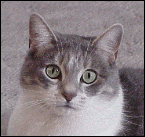Predatory Behavior of Cats

Understanding Your Cat's Predatory Behavior
Cats are born with a hunting and chasing instinct. But they are not necessarily born hunters that kill for food. Killing and eating prey are generally learned behaviors. Hunger will not automatically teach a cat to kill. A cat can be a skillful mouse killer and yet never eat a single mouse or even desire to eat one.
Kittens are programmed from birth to chase. Through play, they develop the coordination and timing needed to successfully capture their target. They learn to adjust their speed to the speed of moving objects. They learn to gauge distance by pouncing. Play gives the kitten a chance to learn to make judgments by experience.
The mother cat teaches her kittens to kill to eat. Her first lesson consists of bringing home dead prey and consuming it in front of the kittens. Soon they learn to join in. At the end of this stage, she brings the dead prey home and leaves it for the kittens to eat on their own. Cats will not only do this for their own litter, but for another cat's kittens as well. Many cats (especially spayed females) will provide this lesson to their human owners. Thus, bringing home dead prey and dropping it at our feet.
The second lesson is bringing home partially dead prey and finishing off the kill in front of the kittens. The kittens are then allowed to practice their skills and learn to kill the wounded, slow-moving prey themselves. Gradually more prey is brought home until the
kittens become skilled at catching and killing them. Finally the kittens accompany the mother and learn to hunt and kill completely on their own.
Why do cats often appear to torture or play with their catch before killing it? There are several theories. One theory is that these cats lack confidence. They may still be wary of their prey which if not killed quickly can fight and bite back. Another theory is that
domestic cats who live in a relatively rodent-free environment lack the opportunity to catch real live prey. When they finally do catch a mouse, they want to prolong the "great" event as much as possible.
If socialization occurs extremely early, it is possible for cats to form friendships with prey animals. Even if a kitten grows up with a hamster or mouse, the two should never be left unattended. If the cat becomes over stimulated, it may suddenly attack and kill its friend
without remorse. Generally, it is better not to try to force these natural enemies to become friends.
Cats pose a threat to the song birds in our gardens. Recent studies indicate that cats kill a minimum of 55 million birds in the UK alone! If your cat must be outdoors, please put a small bell on your cat's break-away collar. This at least will hopefully warn birds of the arrival of your cat and give them ample time to fly away.
Predators living in a "sterile" environment can cause problems. With no real prey to hunt, your cat will still need to express this natural behavior. The result is cats who pretend that people are prey. They play-attack wiggling toes and fingers. They chase imaginary prey up and down the drapes, across table tops and wreck havoc in the process.
You can vent this pent up energy in play with your cat. Find enticing, exciting toys and give your cat the opportunity to hunt, pounce and "kill" these things. Pet stores are filled with toys that move, roll and bounce erratically for your cats entertainment. Toys attached to the end of wands, wires, and string can be waved, dragged and waggled in front of kitty. All these toys and games are supposed to simulate moving prey and stimulate your cat's predatory nature. Take time to play these games with your cat and your cat will also
be less likely to pounce on and bite you in play. An exercised, contented cat will be less likely to go into a wild frenzy of phantom prey chasing in the middle of the night.
Predatory Behavior of Cats
Recommend... Share with friends !